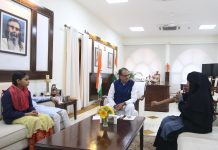
Picture The Last Supper. Jesus and his 12 disciples sitting across a table laden with food and drink, not in Leonardo da Vinci’s classical Renaissance style, but painted in the unmistakable tradition of Indian folk art. The eyes are wide, the human figures asymmetrical, the dimensions flat and da Vinci’s decidedly more grand and solemn backdrop replaced by colourful curtains and a smiling sun and moon. The painting is part of The Last Supper series, a distinctly witty reinterpretation of Jesus’ life by artist Madhvi Parekh.
In a career spanning 50 years, Parekh has exhibited in almost 100 solo and group shows, establishing herself as one of the most respected contemporary artists in India. It is tempting to label her art as simple, with folk and tribal accents. However, as critics have pointed out, there’s more to her body of work; she cleverly incorporates her folk art sensibilities into subjects that are, in turn, drawn from her personal experiences. And so, a typical frame would have animals and birds she saw while growing up in a little village in Gujarat, as well as tall buildings from the cities she has travelled to all over the world. As her contemporary, artist Anjolie Ela Menon says, “She has successfully contemporised elements of folk and tribal art.”
The Last Supper is the 71-year-old artist’s latest work in that tradition. The fact that the Biblical theme differs from her repertoire of indigenous content makes it all the more interesting. And though the women that generally populate her works are absent in this series, there is still that element of rustic nature and fantasy. In The Portrait of Christ I, the all-important star that guided the three wise men to Jesus’ birth is accompanied by the sun and the moon, the divine elements in Hindu mythology. To draw a crowd outside of art aficionados, the first viewing of this work was held in Bishop’s College chapel in Kolkata in 2011. For a week, the paintings stayed in the church, open to the public that came for mass. And now, the Seagull Foundation for the Arts has brought the exhibition to Delhi’s Visual Arts Gallery.
Parekh has always had a child-like fascination for Biblical tales. As a young girl in Sanjaya, the village in Gujarat, she and her three sisters would always be excited about Christmas. “I also had a friend. She was Christian. She would tell me stories, about immaculate conception, the birth in the stable. Those were lovely stories,” recalls Parekh. In 2007, she visited Jerusalem with her artist husband Manu, and the interest eventually translated into an idea for a series. It was a portrait of Christ, absolutely serene and beautiful, in Yad Vashem, the Holocaust memorial, that left her astounded. She also watched people burst into reverent tears at the Unction Stone, where Christ’s body was laid for anointment, or in churches, and all spots considered holy. “These are stories of miracles. There are many in Hindu myths too. It’s very interesting work,” she now says.
Yet, the shapes on canvas are anything but reverent. They are, in curator Alka Pande’s words, “a cross-cultural translation of Biblical stories”. As Parekh’s interest in Christianity preceded her knowledge, she found herself giving her own meanings to Biblical symbols. Noah’s Ark carries 12 disciples, there is a woman seated at the table in The Last Supper (she may or may not be Mary Magdalene) and Jesus the shepherd in Christ Travelling With Animals could be a shepherd from any Indian village. “The flora and fauna of the Bible is drawn in her own style,” Pande points out. And because her point of discovery has been Jerusalem, the city’s tangled history with the Abrahamic faiths pops up on her canvas, with church spires and domes rubbing shoulders.
As an artist, Parekh does not attach much meaning to what goes where on canvas. “There is no particular reason; sometimes things just happen on canvas. It is fantasy,” she says. Perhaps that’s why watching these frames is liberating for a viewer, as they feel free to draw their own interpretations. “What you see around yourself, in the light and in the shadows, can be art. I want to paint what anyone would understand,” says Parekh. There is no grand vision behind this series, but there is a story, a narrative that makes these works even more engaging and accessible.
Perhaps this irreverence has something to do with the fact that Parekh does not have any formal training. She only started drawing at the age of 24, a time when she was living in Bombay and pregnant with her first daughter, and took to painting as a hobby. Her interest was piqued and soon Manu began to teach her the basics. At the beginning, she’d draw circles and squares, and soon she started attaching limbs to those shapes and drawing figures from her village. Staircases became a running motif, an inspiration drawn from a childhood accident when she fell from the stairs. “It’s quite a progress, from drawing squares on a piece of paper to painting The Last Supper. Sometimes I get embarrassed looking back at my early work,” Parekh laughs. “But it is important to see it, and remember where one comes from.” In this progression, argues Menon, she became one of the first artists of her generation to follow in the tradition of Jamini Roy’s folk and tribal art. The reverse painting technique that Parekh eventually began to use in 2006 was inspired by Nalini Malani, an artist Parekh has collaborated with on group shows.
Parekh is not precious about admitting her influences and borrowings; her originality still shines through. “At a time when Indian art was taking a very serious turn, there was wit and humour in her work,” Menon says. In his essay The Centre and the Periphery, critic Jyotindra Jain writes that “Madhvi was not trained in an art school but it is not that she has had no exposure to the world of modern art or to new materials and techniques. She is poised on the fence between her personal world, ‘unspoilt’ by ‘training’, and the formal history of art, which continuously and consciously explores new possibilities of expression.” In the basement of her south Delhi residence, a massive canvas of a new version of The Last Supper is being finished. The style is the same as her other works, but the colour scheme, she says, has been inspired by Pablo Picasso’s iconic Guernica.
Today, Madhvi commands both respect and a high price. Her 48”x72” canvas (Portrait of Christ I) is priced 12 lakh. Her standing in the art fraternity is that of an artist unafraid of pushing the boundaries of imagination. Though she admits it was Manu who taught her how to draw, she is careful about demarcating their work. “My husband, my daughter Manisha and I all paint, but our work is different from each other,” she says firmly. The Last Supper is a convincing evidence of her characteristic humour and a very personal, very unique style.
The Last Supper will be on at the Visual Arts Gallery, New Delhi, from 1 to 7 September
aradhna@tehelka.com













